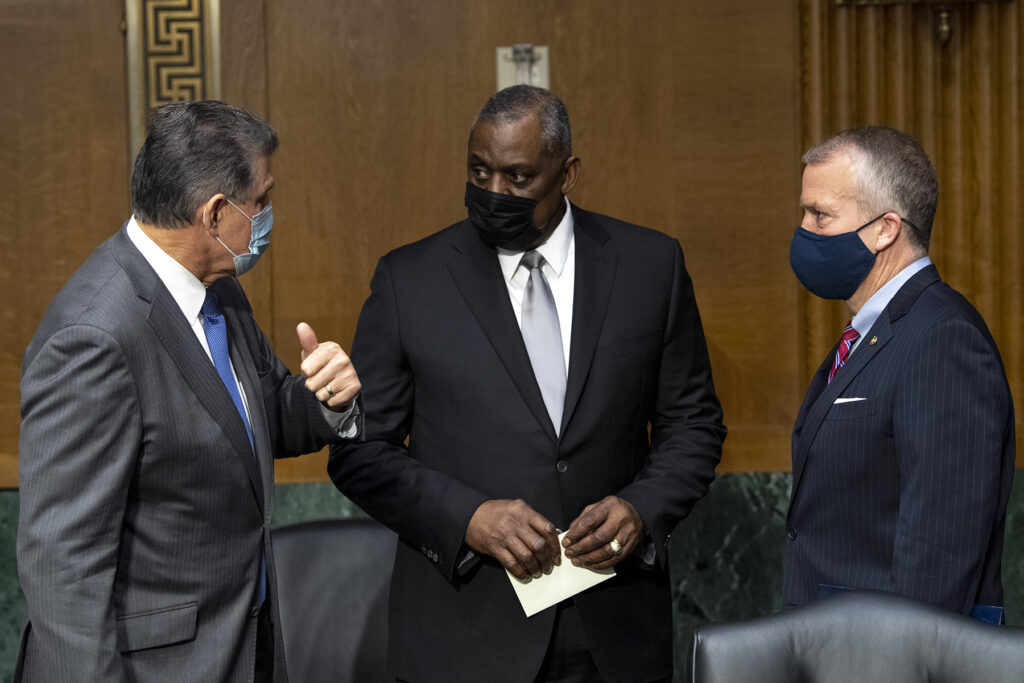
Lloyd Austin meets members of the Senate shortly before his Senate Armed Forces Committee confirmation
WASHINGTON: The threat from China and the fiscal pressure of the COVID-19 pandemic could mean the Pentagon’s traditional split of the budget — roughly one third for each military department — is ripe for change.
It’s not yet clear how the Biden administration will handle the 2022 budget, but the reality of where the threats exist, and how the US will need to spend and posture its forces to meet them, is leading some to rethink the way Pentagon business has been done.
“I think that the past view of a share of any budget needs to go away entirely,” Elaine McCusker, a former DoD comptroller now at AEI, told reporters in a conference call today. Her comments recall the characteristically blunt assessment delivered in December by Gen. Mark Milley, Chairman of the Joint Chiefs, who said the Army and Air Force will have to pay to grow the size of the Navy and Space Force to meet the challenge presented by China in the Pacific and Indian oceans.
“I think we really need to look at joint solutions across the enterprise and the budget as a whole when we go and decide what sort of capabilities we need to meet our strategy,” McCusker said. “I don’t think we should be grading ourselves first and foremost, from a ‘I will copy and paste what I got last year. And that’s my entitlement for this year,” posture.”
That’s another way to express something akin to Milley’s view that the old rules don’t apply anymore. “I would advocate, and bias going forward, heavy investment” in sea, air and space-centric platforms, Milley said. As for the other priorities, he said, “none of it gets cut to zero; this is a matter of balancing things. It’s a very, very difficult exercise we’re going to have to go through. It’s going to be ruthless. There’s going to be a lot of bloodletting and a lot of stuff left on the floor.”
Milley, of course, doesn’t build budgets. The job of chairman is to provide the president with his best military advice. But the chairman’s ability to walk into both the Oval Office and the Defense Secretary’s suite gives him a unique window into how strategy is shaped and debated, and his views on where he believes money should be spent matters. And, of course, he chairs the meetings of the Joint Chiefs.
The defense budget the Trump administration released during the lame-duck period for 2022 moved billions around in ways that the new administration might not be comfortable with, but it did set down certain markers that the White House must now decide to reject, accept or ignore.
“The ‘22 budget review is a priority in the Pentagon right now,” Navy CNO Adm. MIke Gilday told me last week.
Chief among the things for review is the roughly $167 billion the budget called to be pumped into the Navy’s account over the next five years, starting with a $27 billion shipbuilding budget in 2022, a huge increase from the $19 billion requested in 2021. That account would balloon to $33 billion by 2026.
Gilday confirmed that his staff is using the Trump administration’s published 2022 numbers as a guideline for how it’s talking to the new team under Defense Secretary Lloyd Austin and newly confirmed Deputy Defense secretary Kathleen Hicks.
“What we’re doing is presenting the approach that we had under the previous administration that produced DoD’s budget submission a few months ago,” he said. “We’re laying out all the analysis that went into that, and for the Navy, shipbuilding was a big piece of that — shipbuilding and lethality with respect to distributed fires.”
Gilday understands the fiscal pressure the new administration faces, and that new leaders bring new priorities, but his research and development goals remain the same — a focus on hypersonic weapons and long-range fires.
The admiral said he expects the plans hatched last year will get a thorough review from Secretary of Defense Austin and his Deputy Kathleen Hicks, both of whom said in their Senate testimony testimony they will conduct their own deep dives into the effort.
Overall, Gilday thinks the Navy is “in a good place,” since the Pentagon’s powerful Cost Assessment and Program Evaluation official blessed the plan just three months ago. “As we present that analysis to senior decision makers, and we really relitigate, if you will, the ‘22 budget submit — which was very heavily in the Navy’s favor with respect to shipbuilding.”
China’s new H-20 stealth bomber ‘not really’ a concern for Pentagon, says intel official
“The thing with the H-20 is when you actually look at the system design, it’s probably nowhere near as good as US LO [low observable] platforms, particularly more advanced ones that we have coming down,” said a DoD intelligence official.


























